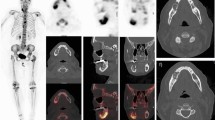Abstract
Purpose
18F-fluoride bone positron emission tomography (PET) has been reported as a useful bone imaging modality. However, no clinical bone PET study had been performed previously in Korea. The authors investigated the usefulness of 18F-fluoride bone PET in Korean patients with malignant or benign bone disease.
Methods
Eighteen consecutive patients (eight women, ten men; mean age, 55 ± 12 years) who had undergone 18F-fluoride bone PET for the evaluation of bone metastasis (n = 13) or benign bone lesions (n = 5) were included. The interpretation of bone lesions on 18F-fluoride bone PET was determined by consensus of two nuclear medicine physicians, and final results were confirmed using combination of all imaging studies and/or clinical follow-up. The analysis was performed on the basis of lesion group.
Results
Thirteen patients with malignant disease had 15 lesion groups, among which seven were confirmed as metastatic bone lesions and eight were confirmed as non-metastatic lesions. 18F-fluoride bone PET correctly identified six of seven metastatic lesions (sensitivity, 86%), and seven of eight non-metastatic lesions (specificity, 88%). On the other hand, five patients with benign conditions had five bone lesion groups; four were confirmed as benign bone diseases and the other one was confirmed as not a bone lesion. 18F-fluoride bone PET showed correct results in all the five lesion groups.
Conclusions
18F-fluoride bone PET showed promising potential for bone imaging in Korean patients with malignant diseases as well as with various benign bone conditions. Therefore, further studies are required on the diagnostic performance and cost-effectiveness of 18F-fluoride bone PET.





Similar content being viewed by others
References
Blau M, Ganatra R, Bender MA (1972) 18F-fluoride for bone imaging. Semin Nucl Med 2:31–37
Lee WW, So Y (2008) Skeletal system. In: Chung JK, Lee MC (eds) Nuclear medicine. Korea Medical Book Publisher, Seoul, pp 509–571
Grant FD, Fahey FH, Packard AB, Davis RT, Alavi A, Treves ST (2008) Skeletal PET with 18F-fluoride: applying new technology to an old tracer. J Nucl Med 49:68–78
Thrall JH (1976) Technetium-99 m labeled agents for skeletal imaging. CRC Crit Rev Clin Radiol Nucl Med 8:1–31
Schirrmeister H, Guhlmann A, Kotzerke J, Santjohanser C, Kuhn T, Kreienberg R et al (1999) Early detection and accurate description of extent of metastatic bone disease in breast cancer with fluoride ion and positron emission tomography. J Clin Oncol 17:2381–2389
Schirrmeister H, Glatting G, Hetzel J, Nussle K, Arslandemir C, Buck AK et al (2001) Prospective evaluation of the clinical value of planar bone scans, SPECT, and 18F-labeled NaF PET in newly diagnosed lung cancer. J Nucl Med 42:1800–1804
Even-Sapir E, Metser U, Flusser G, Zuriel L, Kollender Y, Lerman H et al (2004) Assessment of malignant skeletal disease: initial experience with 18F-fluoride PET/CT and comparison between 18F-fluoride PET and 18F-fluoride PET/CT. J Nucl Med 45:272–278
Piert M, Winter E, Becker GA, Bilger K, Machulla H, Muller-Schauenburg W et al (1999) Allogenic bone graft viability after hip revision arthroplasty assessed by dynamic [18F]fluoride ion positron emission tomography. Eur J Nucl Med 26:615–624
Piert M, Zittel TT, Jahn M, Stahlschmidt A, Becker GA, Machulla HJ (2003) Increased sensitivity in detection of a porcine high-turnover osteopenia after total gastrectomy by dynamic 18F-fluoride ion PET and quantitative CT. J Nucl Med 44:117–124
Brenner W, Vernon C, Muzi M, Mankoff DA, Link JM, Conrad EU et al (2004) Comparison of different quantitative approaches to 18F-fluoride PET scans. J Nucl Med 45:1493–1500
Brenner W, Vernon C, Conrad EU, Eary JF (2004) Assessment of the metabolic activity of bone grafts with 18F-fluoride PET. Eur J Nucl Med Mol Imaging 31:1291–1298
Lim R, Fahey FH, Drubach LA, Connolly LP, Treves ST (2007) Early experience with fluorine-18 sodium fluoride bone PET in young patients with back pain. J Pediatr Orthop 27:277–282
Ovadia D, Metser U, Lievshitz G, Yaniv M, Wientroub S, Even-Sapir E (2007) Back pain in adolescents: assessment with integrated 18F-fluoride positron-emission tomography-computed tomography. J Pediatr Orthop 27:90–93
Author information
Authors and Affiliations
Corresponding author
Rights and permissions
About this article
Cite this article
Kang, J.Y., Lee, W.W., So, Y. et al. Clinical Usefulness of 18F-fluoride Bone PET. Nucl Med Mol Imaging 44, 55–61 (2010). https://doi.org/10.1007/s13139-009-0001-8
Received:
Revised:
Accepted:
Published:
Issue Date:
DOI: https://doi.org/10.1007/s13139-009-0001-8




